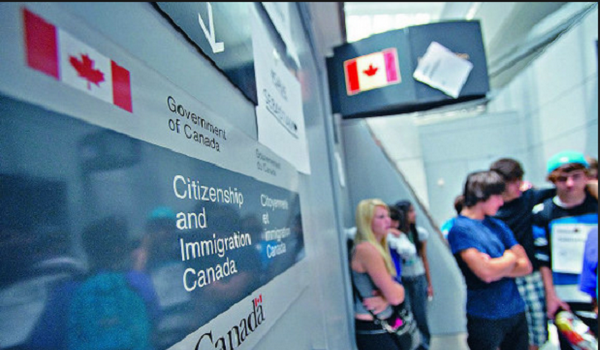Ukrainians on temporary visas find it hard to make ends meet as asylum claims increase in Canada
After Russian President Vladmir Putin declared war on Ukraine, Alex Mokretskyi fled Kyiv with wife, infant son and mother-in-law.
Mokretskyi is one of hundreds of thousands of Ukrainians who were granted three-year work permits under a special federal immigration program to help them wait out the war. Although the Ukrainians are fleeing conflict, they are not considered refugees.
Since arriving in Ottawa, Mokretskyi has struggled to support his family. He and his wife, Maryna, are both trained lawyers, but their skills didn’t translate into equivalent Canadian jobs. The first job he found was a dishwasher working 14 hour days.
Mokretskyi is now delivering food to shelters for the Union Mission, and working as a cook at Eggspectations. Even with two jobs, he’s finding it difficult to make ends meet. The largest chunk of his paycheque is eaten up by rent which costs him $2,500 a month for a two bedroom apartment.
“I work two jobs, now I try to find more work. I don’t have off days. But I know it’s not just for me,” said Mokretskyi as he loaded a van for a food delivery. “It’s for my family, for my future.”
Immigration minister Marc Miller said Canada will have close to “300,000 arrivals of Ukrainians” by the end of March under the special visa program. That amounts to nearly 12 percent of the 2.5 million temporary residents who are currently in Canada. Some may not have been able to find housing or work.
Last week, Miller announced new targets for temporary residents. By 2027, the federal government wants to reduce the number of people working, studying and living temporarily in Canada to five per cent of the overall population, down from over six per cent. Each province will have different quotas which have yet to be negotiated.
At that news conference, Miller also acknowledged the strain record levels of global migration was putting on Canada’s housing, health and social welfare system.
Miller said “Canadians should be unabashedly proud of” it’s Ukraine commitment but also said the milestone should also spur an “honest conversation of what this increase in international migration means for Canada as we plan ahead.”
In addition to helping Ukrainians, Canada is also seeing record levels of people seeking asylum, particularly from Latin America.
Figures provided to CTV News by the Immigration and Refugee Board of Canada (IRB) show that the number of refugee claimants had more than doubled in a year’s time.
According to the IRB, 70,223 people made refugee claims in 2022.
In 2023, the IRB received more than 156,000 claims.
That’s a total of 226,255 refugee claimants compared to the 300,000 Ukrainian temporary residents in approximately the same period.
But processing refugee claims can take years.
Miller said “quickly and fairly processing asylum claims is critical to managing the volume of temporary residents.” To buy some time to catch up, Canada is slowing the flow of asylum seekers.
At the end of February, Canada re-imposed visa requirements on Mexican nationals.
There were more than 28,000 people from Mexico who sought asylum last year, the highest of any country. They accounted for nearly 18 per cent of all refugee claims in Canada.
That pressure of global migration is felt acutely at Ottawa Mission. The shelter offers emergency lodging, meals and employment training, along with addiction and trauma counseling for the homeless.
CEO Peter Tilley, says people seeking asylum “had nowhere to go and were being told at the airport to head down to the Mission.”
Tilley says refugees usually make up less than 10 per cent of the shelter’s population, but that number spiked to more than 70 per cent last fall. Asylum seekers now make up about 30 per cent of the Mission’s clients.
“We are putting mats down on the chapel room floor every single night for full beds,” Tilley said, adding the Mission’s staff are ill-equipped to help newcomers navigate the immigration system.
Tilley is calling on the federal government to create support centers for refugee claimants where they first land to provide settlement services so they’re not directed to local shelters who don’t have the resources to help them.
“It’s too much of a demand on our already overburdened system at the Ottawa Mission. What the federal government has to do is get in the game to provide the support they need,” Tilley said.
In January, the federal government announced $362 million to help house refugees. The city of Toronto will get $143 million, while the province of Quebec will get $100 million.
The rest of the money will be split between other cities in Canada.
But refugee stays in shelters are also being prolonged by bureaucratic barriers to getting a job and steady income.
It can take months for asylum seekers to get their applications for work permits approved, unlike Ukrainians such as Mokretskyi, who arrived with visas to work under the special program.
Mokretskyi was trained through the Mission’s food service program which helped him get his two current jobs working in a restaurant kitchen and driving a catering truck. Tilley laments that he can’t provide the same training for all the shelter clients who want it.
“Most refugees are driven. Newcomers, if given the chance, can succeed, but not at the numbers we’ve seen flooding through our doors.” Tilley said.
Another part of the federal strategy to limit temporary residents could push employers to hire more newcomers faster.
The government wants companies to hire more people domestically, so its reducing the number of foreign workers employers can hire from outside of Canada. Starting in May, only 20 per cent of a company’s staff can come from overseas, down from 30 per cent.
Only the housing and health care sector, which have sizable labour shortages, are exempt from the new cap.
This article was first reported by CTV News













